- About Us
- Columns
- Letters
- Cartoons
- The Udder Limits
- Archives
- Ezy Reading Archive
- 2024 Cud Archives
- 2023 Cud Archives
- 2022 Cud Archives
- 2021 Cud Archives
- 2020 Cud Archives
- 2015-2019
- 2010-2014
- 2004-2009
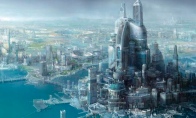 |
150 Issues Of The Cud- May 2010: Hallucinatory Architecture of the Future |
We can't stop fantasizing about living in an urban utopia: some try to give their fantasies a realistic foundation, to ground them in the brick and mortar of today... while others have the architectural visions of the World Of Tomorrow that are more ... well, visionary.
(Hydro-Net futuristic urban project for San Francisco - more info)
(futuristic medical center - more info; and MAD architects concepts, like this one)
Some examples of the early pulp illustration (still unmatched in their retro-futuristic grandeur) - New York in 2032:
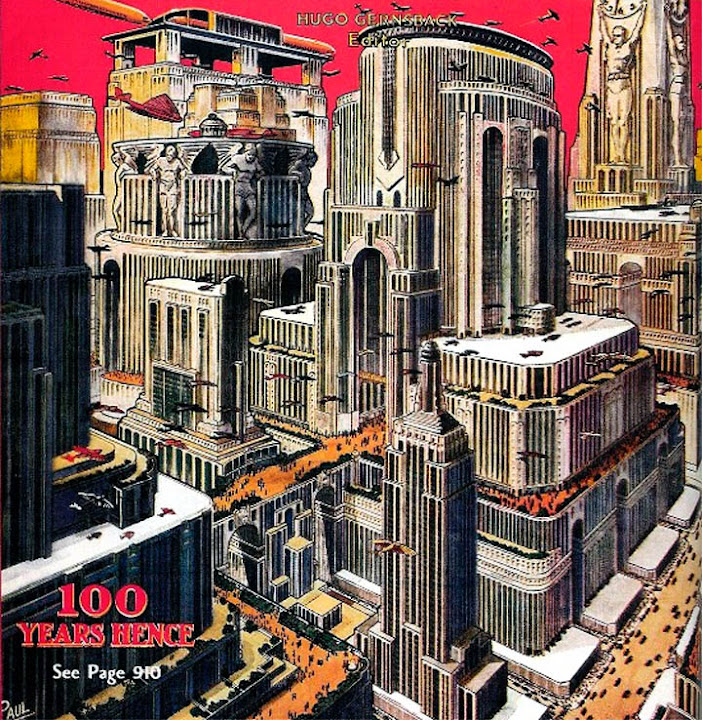
(fragment of the cover of the "Science & Mechanics" magazine, 1931)
Sliding pavements - and the Depth-scraper! (concept from 1931):
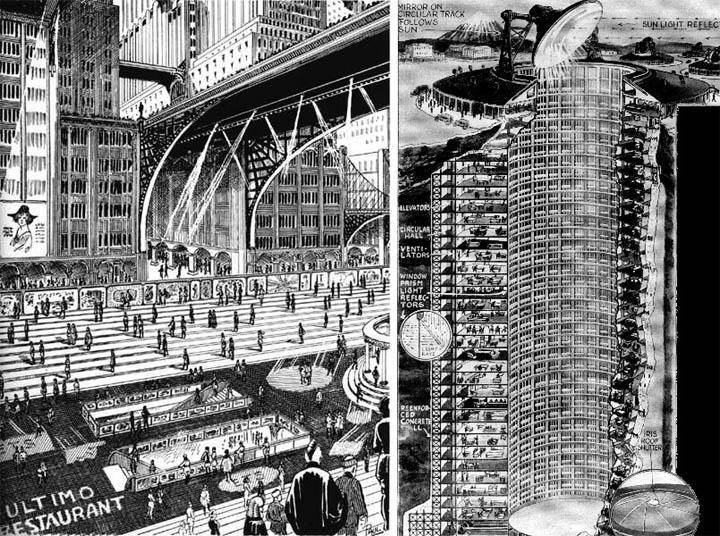
(images via)
The future city by Francisco Mujica: an utilitarian "nightmare":

(image via)
Even worse, a soul-deadening "Cube City" (1930) -

Burj Dubai (or Burj Khalifa) inspiration: the Mile High Illinois
Frank Lloyd Wright was -- without hyperbole -- brilliant. Looking at his designs, it's easy to view them as simple in their loveliness: elegant mixtures of natural and artificial, Asian and Western, minimal and dramatic. But it's easy to forget that Wright completely rewrote architecture when the cars parked in front of his houses were Model T Fords. It's one thing to dream about the future when you're in a world -- like today -- that's always looking forward, always thinking of grandly dramatic tomorrows, but quite another when you're in a time when men are wearing spats, and women hoop skirts -- and the future was relegated to cheap pulps, at best.
And Wright certainly had his eyes to the future. One of his most visionary designs was of a decentralized city, called Broadacre. Although not as striking as some of his other designs, it was radical for its time. But even more radical was what was to be Wright's masterpiece, a single soaring accomplishment: The Illinois.
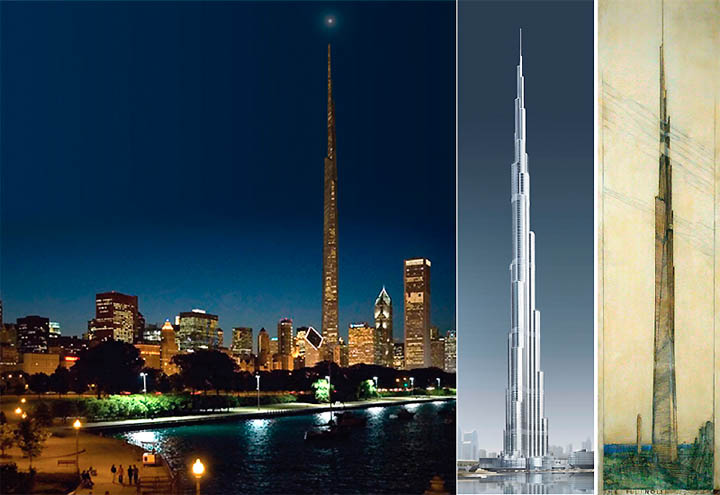
Soaring is right, as the Illinois was to be a skyscraper -- a rare thing for Wright. But not just any twenty or thirty or forty floor pinnacle of his skill. Nope, The Illinois was to be a Chicago landmark to end all landmarks: a mile-high skyscraper.
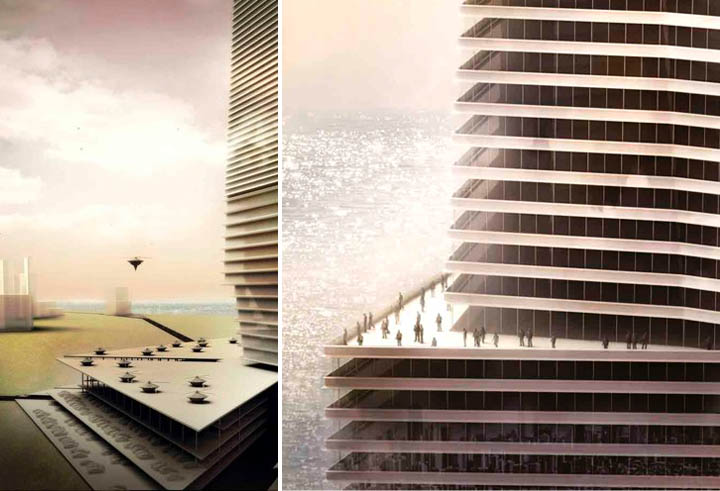
(images via 1, 2)
Alas, Wright never came close to seeing his creation as anything but sketches and blueprints.
Floating Atlantis Hotel, 1928:

(images via)
Another architectural visionary with very long-distance sight was Buckminster Fuller. Bucky created what some consider overly practical geodesic and polished steel future with a staggering array of designs and inventions -- many of which had gone beyond the blueprint stage and could be seen, touched, or even driven. Like Wright's, his designs were often even more incredible in light of when they were created. His Dymaxion House, for example, was created in 1929, and his amazing Dymaxion car actually drove the streets of New York in 1933. Fuller's designs were, to put it mildly, rigorously practical: his Dymaxion Houses were to be created on an assembly line with inflexible specifications, not in their manufacture but for those who were to live in them.

(image via)
The houses might have been absolutely brilliant in their design -- integrating many inspired features such as their ability to recycle water -- and his car literally could have driven rings around the cars of 1944, but in Fuller's future visions humanity would have been less flesh and blood and more like uniform parts in his many intricate mechanisms.
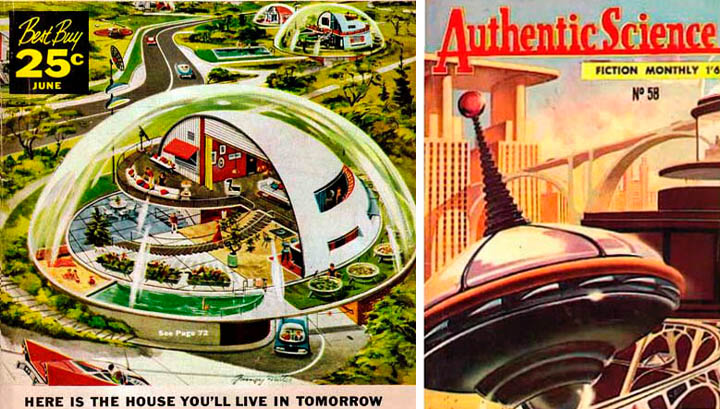
A world of living green: a vision by Luc Schuiten
Other architects and visionaries have taken a much more natural approach to their far-forward speculations and designs. Luc Schuiten, for instance, looked at tomorrow and saw not steel and chrome, metal and heavy industry but instead a world of living green. It's called Archiborescence - his designs are for cities grown and tended like orchards. Living in Luc's world would be like existing in a city of skyscraper trees, hedgerow houses, forest stores, and prairie parks - a magnificent dream for those who long for man to finally live with- and not against - nature ... though maybe a ring of hell if you have an hay fever.
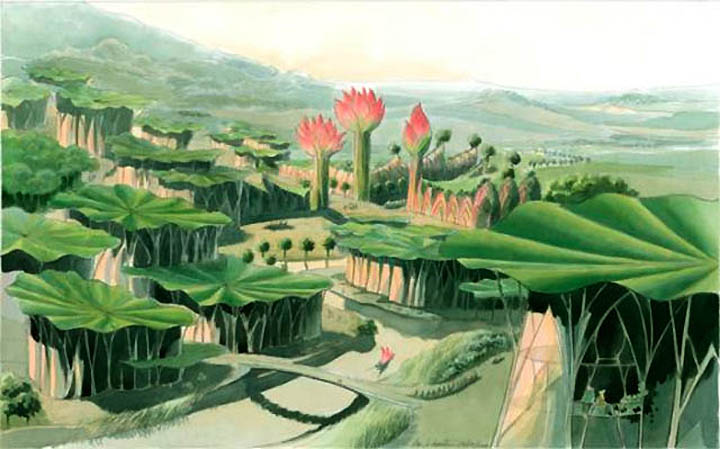

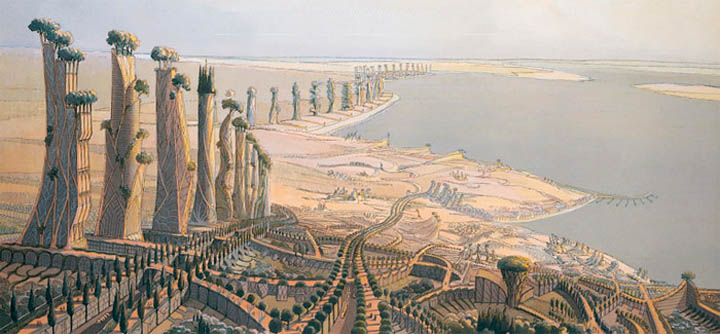


(images by Luc Schuiten, via)
Communist Gothic: Architectural Visions by Yakov Chernyakov, 1920s - 1930s
I've written elsewhere before about Yakov's stupendous imperial urban dreams - click here. Here are a couple more glimpses of his baroque-looking mega cities:


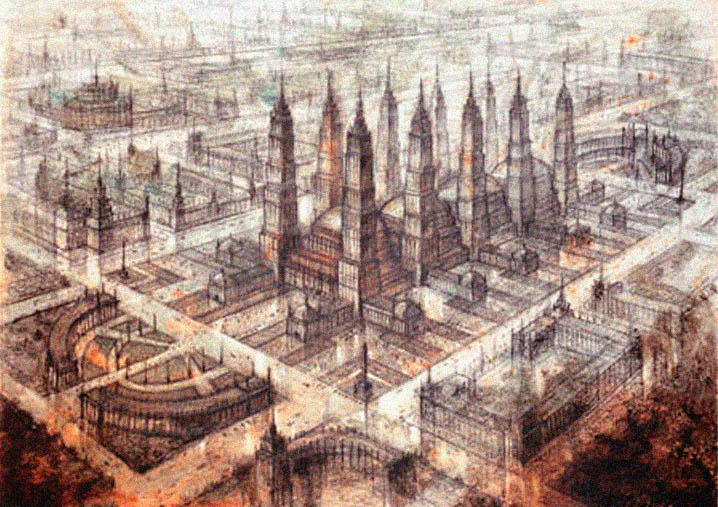



(images via)
Wright is art, Fuller is cold logic, Luc is nature, but if you want a vision of the future that's none of the above, in every way, you have to look at the work of Superstudio. Created in 1966 by Adolfo Natalini and Cristiano Toraldo, Superstudio's plans for the future are outrageous, disturbing, and -- most of all -- surreal.
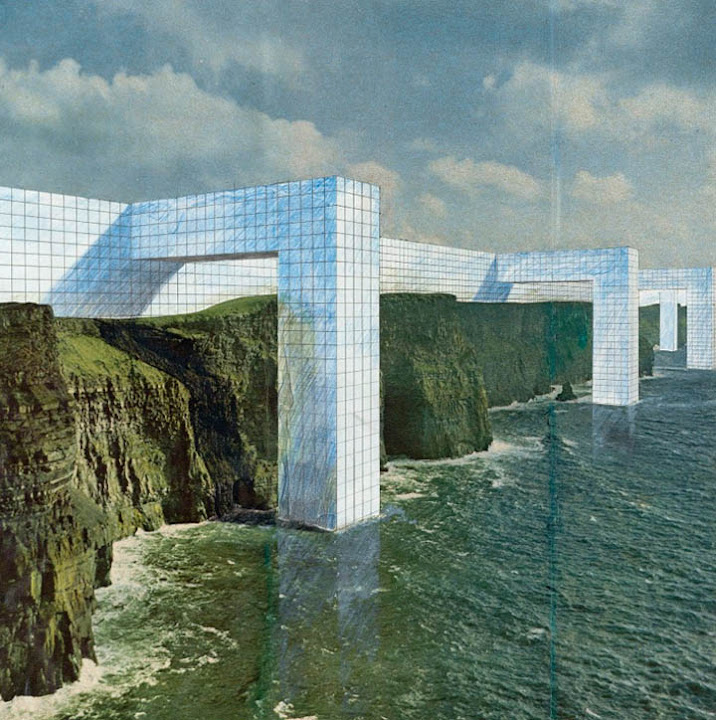

(image credit: Adolfo Natalini, The Museum of Modern Art)
To be fair, Natalini and Toraldo never really thought about actually creating their visions of the future -- unlike Wright and Fuler and Luc -- and, considering some of their designs, that might be a very good thing.
Take, for example, their plan to make all the buildings in Pisa lean -- every building except for the town's famous tower; or their famous "Brain City" where the residents would be just that: brains in jars, with the concept of a perfect city fed into their cortexes via direct stimulation.

A contemporary of Superstudio, Archigram created designs that weren't quite as avant guard -- in fact they were almost realistic, at least in comparison. One of their most famous visions is for a city that perambulates across the countryside ... and before you leap to your dictionary, they meant for their cities of the future to be monstrous walking machines, strolling from one part of the world to the other.
Tomorrow might not be here yet, but thankfully there have been, and still are, some dreamers who have tried to look forward to how we might be living. All we can do is hope that some of their more outrageous visions become a reality, and that others never do.
From more realistic near-future visions (click to enlarge):

(image credit: Meduza Arts, Moon City Productions)

(image credit: Mark Goerner)
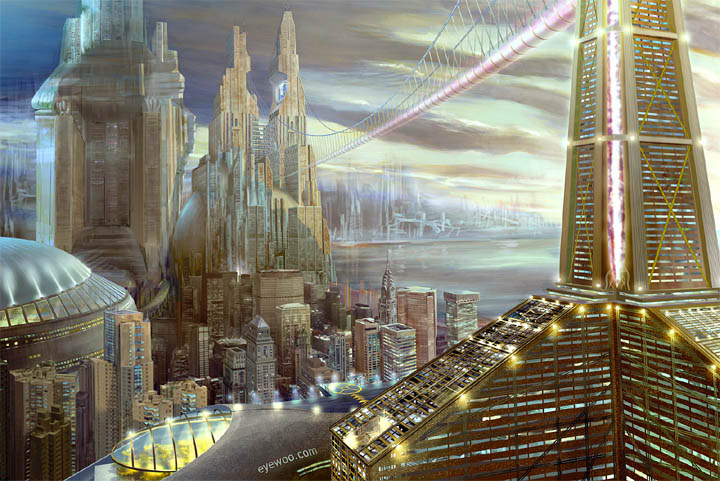
(image credit: Philip Williams)
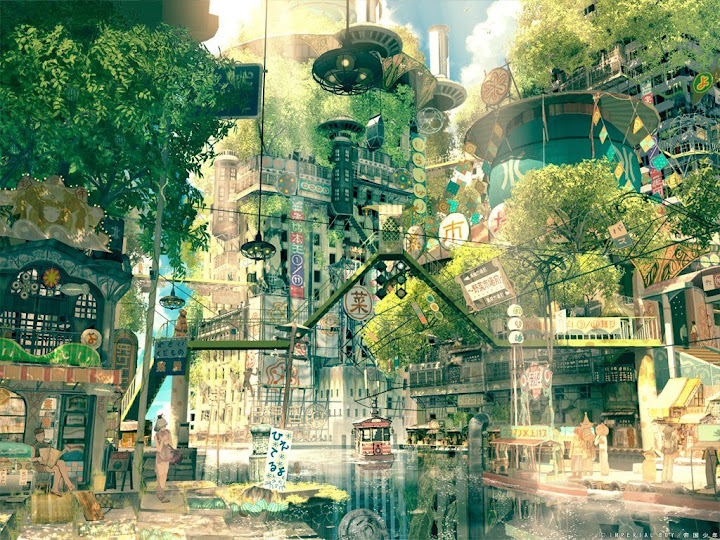
(originals unknown)
... to wild stuff, like this overgrown "Coruscant" for example:

(image credit: Craig Mullins)
'Shroom City, by Frederic St. Arnaud (click to enlarge):

Waterfall Castle, also by Frederic St. Arnaud:
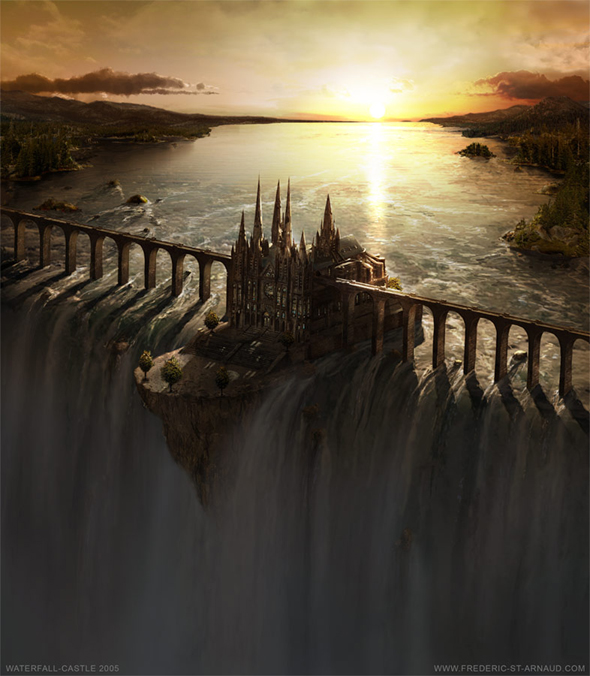
(art by Frederic St. Arnaud)
This article originally appeared on Dark Roasted Blend.
M.Christian has published more than 300 published short stories, is the editor of over 20 anthologies - including The Burning Pen, Guilty Pleasures, The Mammoth Book of Future Cops and The Mammoth Book of Tales of the Road (with Maxim Jakubowksi) and Confessions, Garden of Perverse, and Amazons (with Sage Vivant) - and is the author of the collections Dirty Words, Speaking Parts, The Bachelor Machine, Licks & Promises, Filthy, Love Without Gun Control, Rude Mechanicals, and Coming Together: M.Christian; and the novels Running Dry, The Very Bloody Marys, Me2, Brushes, and Painted Doll.




